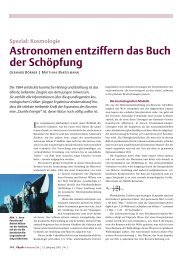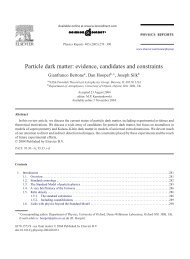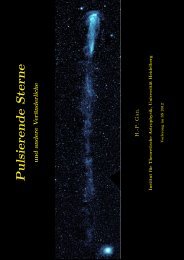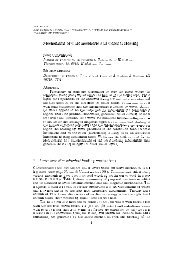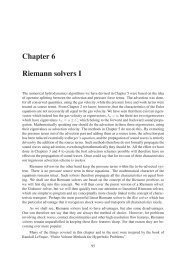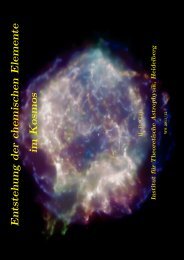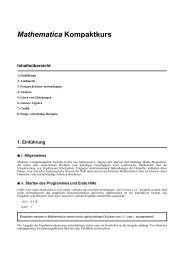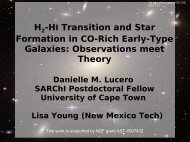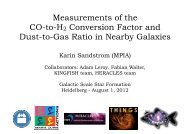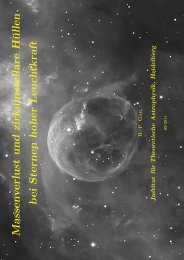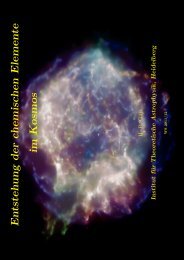Star Formation in Molecular Clouds
Star Formation in Molecular Clouds
Star Formation in Molecular Clouds
You also want an ePaper? Increase the reach of your titles
YUMPU automatically turns print PDFs into web optimized ePapers that Google loves.
<strong>Star</strong> <strong>Formation</strong> <strong>in</strong> <strong>Molecular</strong> <strong>Clouds</strong><br />
Collaborators:<br />
Ralf Klessen (ITA)<br />
Ian Bonnell (St Andrews)<br />
Hans Z<strong>in</strong>necker (AIP)<br />
Matthew Bate (Exeter)<br />
Jim Dale (Leicester/ITA)<br />
Clare Dobbs (Exeter)<br />
Simon Glover (AIP)
What we th<strong>in</strong>k we know…<br />
From observations of the embedded phase:<br />
• Nearly all star formation takes place <strong>in</strong> giant molecular clouds (GMCs)<br />
M ~ 10 4 M ! to 10 6 M ! ; T ~ 10 to 40K ; n ~ 100 cm -3<br />
<strong>Clouds</strong> are highly structured and conta<strong>in</strong> highly supersonic turbulent motions.<br />
<strong>Star</strong> formation efficiency is thought to be low, around a few percent.<br />
• <strong>Star</strong>s tend to form <strong>in</strong> mass segregated clusters, rather than <strong>in</strong> isolation.<br />
• At least locally, the whole process of star formation appears to be more rapid<br />
than the old SF models suggest (! 6 Myrs). Might not be true <strong>in</strong> general though!<br />
From the field star population:<br />
• The mass function of stars, (<strong>in</strong>itial mass function or IMF) appears to be constant,<br />
and has a reasonably well def<strong>in</strong>ed shape.<br />
• B<strong>in</strong>ary statistics
A new observational era<br />
Sub-millimetre observations<br />
of dust emmission:<br />
• Arrival of new<br />
<strong>in</strong>strumentation now permits<br />
the construction of column<br />
density maps of entire star<br />
form<strong>in</strong>g regions.<br />
• Has (arguably) less<br />
uncerta<strong>in</strong>ties <strong>in</strong> the<br />
<strong>in</strong>terpretation than one f<strong>in</strong>ds<br />
<strong>in</strong> l<strong>in</strong>e-width studies.<br />
• Provides perhaps some of<br />
the best mass measurements<br />
for molecular clouds.<br />
• Probes a fairly large density<br />
regime.<br />
Motte, André & Neri 1998, A&A 336, 150
Clumps <strong>in</strong> the cores of ! Oph<br />
Use a ‘wavelet’ analysis approach to f<strong>in</strong>d<strong>in</strong>g<br />
the clumps, rather than CLUMPFIND or<br />
GAUSSCLUMP<br />
Motte et al (1998) studied the cores <strong>in</strong> ! Oph:<br />
• Throughout the 6 cores, f<strong>in</strong>d 59 starless<br />
‘clumps’<br />
• Clumps typically have a size of ~6000 AU but<br />
structure is seen down as far as the resolution<br />
limit will allow (~800AU)<br />
• Typical clump densities are 10 5 to 10 9 cm -3<br />
Motte, André & Neri 1998, A&A 336, 150
Mass function of ‘clumps’<br />
"N # m $ "m<br />
$ = -1.5 m < 0.5<br />
$ = -2.5 m > 0.5<br />
Motte, André & Neri 1998, A&A 336, 150<br />
Looks fairly similar to the stellar IMF
Mass function of ‘clumps’<br />
! Oph<br />
• Results of Motte et al (1998)<br />
have been confirmed by<br />
Johnstone et al 2000 for ! Oph,<br />
us<strong>in</strong>g different methods<br />
• Also seems to be true for<br />
other regions of SF<br />
Johnstone et. al. 2000, ApJ, 545, 327<br />
Serpens<br />
Orion B<br />
North<br />
Johnstone et. al. 2001, ApJ, 559, 307<br />
Testi & Sargent 1998, ApJ, 508L, 91
Turbulence and the creation of the IMF<br />
• Scal<strong>in</strong>g laws for turbulent motions (i.e. the ‘Larson’ laws) suggest that each<br />
scale <strong>in</strong> a cloud is characterised by a particular Mach number of shock.<br />
(isothermal gas).<br />
• Length of flows is also comparable to the size scale, L.<br />
• Identify post-shock (and thus denser) gas with ‘clumps’<br />
• Can create a scal<strong>in</strong>g law which relates the mass of the<br />
clump to the length-scale:<br />
Padoan & Nordlund 2002,<br />
ApJ, 576, 870<br />
• Us<strong>in</strong>g some mass conservation arguments can show that<br />
the number of clumps of a given mass is:<br />
• For MHD turbulence, with $ = 0.37 (Boldyrev et al 2002<br />
ApJ, 569, 841), gives a mass power of -1.33<br />
(For a magnetically<br />
dom<strong>in</strong>ated gas)<br />
Aga<strong>in</strong>, very similar to the stellar IMF
Primordial IMF ?<br />
Clump observations are prov<strong>in</strong>g popular, s<strong>in</strong>ce they<br />
suggest that IMF is a primordial property of star form<strong>in</strong>g<br />
regions, that we can observe (relatively) easily.<br />
They are also backed by the turbulent fragmentation<br />
theories, along with the more simple, hierarchical,<br />
fragmentation models.<br />
Both these studies suggest that<br />
each ‘clump’ forms 1 star.<br />
Is the IMF solved ?<br />
Change Career ?
Time-scales for clump collapse<br />
1) Assume each clump has ~1 Jeans mass<br />
2) Free-fall time is function of<br />
density too…<br />
3) Which means the collapse<br />
time-scale is proportional to the<br />
mass of the clump:<br />
Clumps collapse on<br />
different time-scales.
Clump mass distribution % stellar MF<br />
Clark, Bonnell & Klessen, In prep.<br />
We can use these time-scales<br />
to predict how the clump<br />
mass spectrum would<br />
evolve <strong>in</strong>to a population of<br />
stars.<br />
Assume three ma<strong>in</strong> po<strong>in</strong>ts:<br />
1) Clump distribution is constant <strong>in</strong><br />
time<br />
2) Each clump has one Jeans mass<br />
3) Each clump collapses on a free fall<br />
time<br />
Evolve for the free-fall<br />
time of the most<br />
massive clump
Required clump mass distribution for stellar MF<br />
Similar to<br />
scal<strong>in</strong>g laws for<br />
clouds (Blitz<br />
1993; Loren<br />
1989)<br />
The required clump mass function is much<br />
shallower than the observed clump mass<br />
functions for these regions.
Multiple systems: multiple problems<br />
Cloud fragmentation has always had a problem form<strong>in</strong>g b<strong>in</strong>aries, s<strong>in</strong>ce<br />
the Jeans length required to form (for example) a G - type star is 4<br />
orders of magnitude larger than its typical separation when found<br />
<strong>in</strong> a b<strong>in</strong>ary system.<br />
Can get around this problem (at least for low mass stars) if we assume<br />
that clumps fragment dur<strong>in</strong>g the collapse, for example <strong>in</strong> some sort<br />
of rotationally supported core phase, <strong>in</strong>to a small N group.<br />
However this breaks the one-clump-one-star picture.<br />
Clumps will likely need to have several Jeans masses to aid the<br />
fragmentation, and more if extra forms of support are present or<br />
acquired dur<strong>in</strong>g collapse.
Multiple systems: observations<br />
• Embedded objects have been shown to have a very high<br />
multiplicity fraction: essentially all the young stellar objects <strong>in</strong> rho<br />
Oph, Serpens and Taurus have been shown to exist as part of a<br />
multiple system.<br />
e.g. Duchêne et. al., 2004, A&A, 427, 651;<br />
Correia et. al. 2006, astro-ph/0608674<br />
• The separations of these systems is typically smaller than, or at<br />
most comparable to, the observed clump sizes <strong>in</strong> these regions.<br />
Suggests that clumps fragment <strong>in</strong>to<br />
small N systems!<br />
One-to-one mapp<strong>in</strong>g too simple.
Multiple systems: clump fragmentation<br />
Investigate fragmentation<br />
of the clump MF:<br />
• <strong>Star</strong>t with a simple<br />
IMF<br />
• Use four different<br />
fragmentation<br />
prescriptions<br />
Fragmentation results<br />
<strong>in</strong> the loss of the<br />
turn-over.<br />
However, the<br />
Salpeter slope is<br />
ma<strong>in</strong>ta<strong>in</strong>ed.
How likely is the one-clump-one-star picture?<br />
B<strong>in</strong>ary stars present a problem for the one-clump-one-star picture:<br />
• Either stars need to form too far apart or fragmentation of the clumps<br />
destroys the turnover <strong>in</strong> the result<strong>in</strong>g IMF.<br />
• However the Salpeter slope is preserved <strong>in</strong> our simple fragmentation<br />
schemes. Still cannot expla<strong>in</strong> the observed properties of high mass stars!<br />
Timescales are a problem:<br />
• Assum<strong>in</strong>g freely collaps<strong>in</strong>g clumps that are both constantly replenished<br />
and have the required roughly 1”Jeans mass” of mass, requires a much<br />
shallower mass function than observed <strong>in</strong> order to yield the correct mass<br />
function of stars.<br />
1 Jeans mass condition is unlikely:<br />
• Why should a flow care about the size of the post shock region?<br />
Turbulent flows are naturally hierarchical:<br />
• So any clump theoretical clump distribution is also hierarchical.
So what is all this clumpy structure?<br />
• Simulations of both driven and freely decay<strong>in</strong>g turbulence AWAYS show<br />
a clump mass spectrum that is similar to the IMF.<br />
• However, only the most massive of these clumps become bound, and<br />
collapse (and fragment) to form stellar groups.<br />
(e.g. Klessen 2001, ApJ, 556, 837; Clark & Bonnell 2005,<br />
MNRAS, 361, 2)<br />
• Constant IMF clump distribution is never a problem, s<strong>in</strong>ce the vast<br />
majority of it is unbound and thus transient.<br />
• Further observations are required to establish whether the observed<br />
clumps are truly bound or not.<br />
Johnstone and collaborators suggest they are not even Jeans<br />
unstable!
Even ridiculous <strong>in</strong>itial conditions….<br />
We ran flows of<br />
<strong>in</strong>itially identical<br />
mass clumps<br />
through a shock.<br />
(Baked Bean Flow)<br />
Absolutely NO gravity was<br />
t = 0<br />
<strong>in</strong>cluded <strong>in</strong> this simulation<br />
t = 0.5 tcr<br />
Mach 10<br />
10% fill<strong>in</strong>g factor<br />
t = 1 tcr<br />
Result<strong>in</strong>g<br />
shredd<strong>in</strong>g/coagulation<br />
produces a clump<br />
mass function with ~<br />
Salpeter slope.<br />
Clark & Bonnell 2006, MNRAS, 368, 1787<br />
…can give the right answer!
Similar results with gravity….<br />
Self gravitat<strong>in</strong>g flow<br />
of Baked Beans this<br />
time!<br />
t = 1 t cr<br />
Mach 10<br />
40% fill<strong>in</strong>g factor<br />
• Only the higher<br />
mass clumps are<br />
bound<br />
• Fragment of these<br />
forms groups of stars<br />
Orig<strong>in</strong>al Jeans mass at<br />
pre-shock density was ~<br />
17 M !
So how do you form the IMF?<br />
Competitive accretion?<br />
• Gas <strong>in</strong>flow due to cluster potential<br />
– to cluster centre<br />
– Higher gas density<br />
Gas <strong>in</strong>flow<br />
• Initially low relative velocities<br />
– Turbulence locally small<br />
– Small-N clusters<br />
• <strong>Star</strong>s <strong>in</strong> centre accrete more<br />
• Higher accretion rates<br />
massive stars<br />
Bonnell et. al. 2001, MNRAS, 324, 573<br />
!<br />
v " r 0.5 Gives a cluster with<br />
Salpeter type slope<br />
AND<br />
mass segregation
Knee of the IMF <strong>in</strong> competitive accretion<br />
• <strong>Clouds</strong> of 1000 M !<br />
but different Jeans<br />
masses<br />
• Knee is controlled<br />
by mean <strong>in</strong>itial Jeans<br />
mass!<br />
Bonnell, Clarke & Bate, 2006, MNRAS 138, 1296<br />
Initial Mj ~ 5 M !
Unbound molecular clouds - naturally low SFE<br />
• <strong>Clouds</strong> which are dynamically<br />
unbound ( KE > PE ) can still form stars<br />
while dispers<strong>in</strong>g on ~2 cross<strong>in</strong>g times,<br />
provided they have multiple Jeans<br />
masses.<br />
Clark & Bonnell 2004, MNRAS, 347L, 36<br />
• Results <strong>in</strong> a naturally low star<br />
formation efficiency.<br />
• Turbulence selects regions for star<br />
formation via the removal of k<strong>in</strong>etic<br />
energy.<br />
GMC with KE = 2 PE<br />
Clark et. al. 2005, MNRAS, 359, 809<br />
M = 10 5 M !<br />
R ~ 20 pc<br />
SFE < 10% after 10Myrs<br />
Forms a series of clusters which have<br />
similar properties to an OB association
Unbound clouds<br />
• How low can the SFE get ?<br />
• What happens to the IMF as clouds become<br />
progressively more unbound ?<br />
Simulations<br />
• Model clouds of 1000 M !<br />
• Use both isothermal and Larson style<br />
EOSs.<br />
• 2,000,000 SPH particles (mass<br />
resolution of ~0.05 M ! )<br />
• Initial density<br />
Knee/normalisation of IMF<br />
depends on mean density<br />
<strong>in</strong> competitive accretion.<br />
Changes with time!<br />
Larson style EOS:<br />
Isothermal: ! o ~ 2 x 10 -19 g cm -3<br />
Larson EOS: ! o ~ 2 x 10 -20 g cm -3
PE / EK = 0.5<br />
Isothermal EOS<br />
T = 10K<br />
M = 1000M !<br />
t ff ~1.5 x 10 5 yr<br />
! o ~ 2 x 10 -19 g cm -3 ~ 1 pc
PE / KE = 0.3<br />
Isothermal EOS<br />
T = 10K<br />
M = 1000M !<br />
tff ~1.5 x 10 5 yr<br />
! o ~ 2 x 10 -19 g cm -3 ~ 1 pc
The star formation efficiency<br />
Isothermal runs<br />
Larson EOS runs<br />
Arbitrarily low SFE is possible. However…<br />
Clark, Bonnell & Z<strong>in</strong>necker, In prep.
…the mass function may end up wrong!<br />
Isothermal runs<br />
Larson EOS runs<br />
Perhaps only large bound can give stellar IMF.<br />
Clark, Bonnell & Z<strong>in</strong>necker, In prep.
Unbound cloud IMFs<br />
• Results of these simulations demonstrate that<br />
arbitrary SFEs are possible:<br />
SFE can be controlled simply by the energy<br />
balance <strong>in</strong> the cloud.<br />
• IMF is sensitive to the dynamical state of the cloud:<br />
Suggests that competitive accretion can only<br />
create the observed IMF <strong>in</strong> bound cluster<br />
conditions.<br />
?<br />
|E P | - E K < 0<br />
|E P | - E K = 0 |E P | - E K > 0<br />
Flat IMF<br />
small N clusters<br />
Stellar IMF Steeper IMF ?<br />
Larger N clusters ?
A Cautionary Note<br />
At the moment, no feed back is <strong>in</strong>cluded <strong>in</strong> the<br />
simulations.<br />
‘S<strong>in</strong>k particles’ are black holes, from which no mass<br />
escapes.<br />
If mass-loss rates are some function of stellar mass, dm/dt<br />
= f(m), then our IMFs from the simulation may not be<br />
enough to capture the essence of the star formation<br />
process.<br />
Problem for fragmentation theories of the IMF and the<br />
competitive accretion model.<br />
Should we be seek<strong>in</strong>g a different IMF from our simulations ?
Summary…<br />
• It is unlikely that the clump mass function and the stellar<br />
IMF are related. The one-to-one mapp<strong>in</strong>g required<br />
conta<strong>in</strong>s too many problems.<br />
• Competitive accretion is an attractive concept, s<strong>in</strong>ce it<br />
can expla<strong>in</strong> more than just the IMF.<br />
• However it is very sensitive to the cloud conditions,<br />
and may not give the right answers everywhere.



